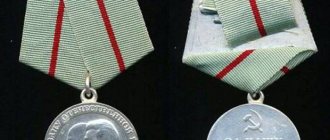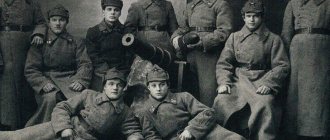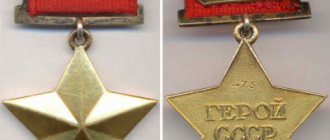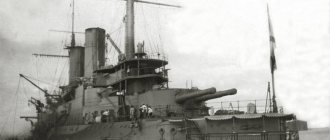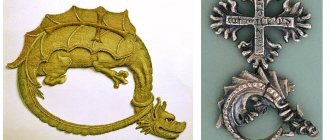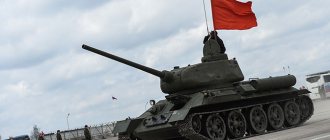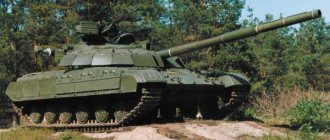History of the medal for the defense of Leningrad
For the defense of Soviet cities and regions where the enemy suffered particularly heavy losses, award medals were established and awarded to all active participants in these events. Despite the difficult, formidable time, the design of the future award was carefully developed. Many sketches were created, from which the most successful was finally chosen. At the end of October 1942, newspapers reported that the People's Commissariat of Defense was petitioning for the establishment of medals for the defense of Leningrad , Sevastopol, Stalingrad and Odessa. On November 24, the Supreme Commander-in-Chief gave instructions to begin developing their drawings. 43 sketches of future awards made by almost a dozen artists were presented. On December 21, the draft Regulations on medals for the defense of four cities were approved, and by this time only one of the sketches was approved - the medal “For the Defense of Stalingrad” by the artist N. I. Moskalev. But even on this project, Stalin’s hand crossed out the portrait of the Supreme Commander-in-Chief and, on his instructions, some other changes were made. It was proposed to place the inscription “For our Soviet Motherland” on the reverse side of all medals.
The next day, December 22, a Decree of the Presidium of the Supreme Soviet of the USSR was signed on the establishment of medals “For the Defense of Leningrad”, “For the Defense of Odessa”, “For the Defense of Sevastopol” and “For the Defense of Stalingrad”. At the same time, a description of future awards appeared. Somewhat later, in March 1943, some changes were made to the description. Thus, it was initially proposed to make medals from stainless steel, but for technological reasons this metal was replaced by brass. According to the Decree of December 22, medals were to be worn on the right side of the chest, and from June 19, 1943, these awards began to be worn on the left.
One of the most tragic and at the same time heroic pages in the history of the Great Patriotic War - the defense of Leningrad in 1941-1944 - will forever remain in the memory of our people. Cut off from the rest of the country, the city steadfastly withstood the onslaught of advancing fascist troops during the 900-day blockade. Great contribution to the defeat of the Nazis near Leningrad and civilians of the city. Despite the fact that almost a hundred large enterprises were evacuated, the production of military products did not stop for a single day. Leningrad factories provided the front with hundreds of tanks, thousands of guns and mortars, and large and small combat ships were built at the city's shipyards during the days of the siege. In addition, Leningraders dug hundreds of kilometers of anti-tank ditches and built thousands of pillboxes and bunkers. Numerous barricades were erected in the city itself in case the invaders broke through.
The struggle did not subside in the rear of the Nazis. In 32 months, the partisans of the Leningrad region destroyed about 114 thousand Nazi soldiers and officers, hundreds of aircraft, tanks, vehicles, and derailed more than 1,100 enemy trains with troops and equipment. In January 1943, the enemy blockade of Leningrad was broken, and in 1944 it was completely eliminated. But back in December 1942, when fascist guns fired at almost the entire territory of the city, and the Nazis could look at Leningrad buildings through binoculars, the medal “For the Defense of Leningrad” was established to reward all active participants in the defense of the city on the Neva. After a series of discussions of the projects, a sketch of the medal by the artist N. I. Moskalev was approved: against the background of the Admiralty, as a symbol of the city, figures of a Red Army soldier, a Red Navy man, a worker and a worker with rifles at the ready are depicted, personifying the readiness of the city’s defenders to fight.
***
Orders and medals of the Great Patriotic War - awards of 1943.
In 1943, three new orders and a medal appeared.
Order of Bohdan Khmelnytsky
appeared on October 10, 1943 at the suggestion of Nikita Sergeevich Khrushchev, who was at that time a member of the Military Council of the 1st Ukrainian Front. This military order had three degrees and was awarded for the same merits as the Orders of Suvorov and Kutuzov, that is, for skillfully organized military operations and successful actions of entrusted units. The difference was that this order was awarded not only to the commanders of the Red Army, but also to the commanders of partisan detachments and units. The Order of Bohdan Khmelnitsky, III degree, could also be awarded to ordinary personnel if their actions contributed to the success of the unit as a whole. This was the only Soviet order, the inscription on which was made not in Russian, but in Ukrainian. The First Class Order was made entirely of gold. The II degree of the order had only a central circle made of gold, and the star was made of silver; the III degree order was made entirely of silver.
Order of Glory
was established on November 8, 1943, and had three degrees. It was awarded for personal bravery to privates and non-commissioned officers; in aviation, the Order of Glory was also awarded to junior lieutenants. The awards, as a rule, were made sequentially: first with the third, then with the second and then with the first degree. The Order of Glory, 1st degree, was made of 950 gold. The Order of Glory, II degree, is made of silver, but the circle with the image of the Kremlin was gilded. The Order of Glory, III degree, was made of silver.
Order "Victory"
- the highest military order, appeared simultaneously with the Order of Glory in 1943. It was awarded to particularly distinguished commanders. In total, there were 15 holders of the order at the end of the war, 5 of them were foreigners. The materials from which the order is made are platinum, gold, silver, five artificial rubies weighing 5 carats each, 174 small diamonds. A total of 22 orders were made, some of them were not awarded.
Medal "Partisan of the Patriotic War"
was established on February 2, 1943 and had two degrees. The first class medal was made of silver, the second class – from brass. The medal was awarded not only to Soviet partisans, but also to foreign citizens, anti-fascists who fought in Soviet partisan detachments. The largest medal award during the Great Patriotic War was made for the partisan operation “Concert” in September - November 1943. This operation preceded the offensive of Soviet troops. It was carried out by 193 partisan detachments of one hundred and twenty thousand people and consisted of a large-scale undermining of railway tracks, railway bridges and trains in an area about 900 kilometers along the front and over 400 kilometers in depth from the front line.
Awarding the medal "For the Defense of Leningrad"
According to the Decree of the Presidium of the Supreme Soviet of the USSR dated December 22, 1942, all military personnel and civilians who took an active part in the defense of the city could be nominated for the medal “For the Defense of Leningrad”. Moreover, those who participated in the defense of Leningrad not for the entire period of the siege, but left the city due to injury, illness, or to carry out government assignments, were also entitled to receive a medal. At the very beginning of 1943, the Leningrad Mint received a responsible order - to produce the first batch of medals “For the Defense of Leningrad”. By that time, the most valuable equipment and most of the company's specialists had been evacuated. In the besieged city, a few hungry workers and engineers worked on making awards, confident that Leningrad would never be given over to the enemy. Already in April, the first thousand medals were awarded to the city’s defenders on the front line.
In total, about 1 million 470 thousand people were awarded the medal “For the Defense of Leningrad”. In 1945, Leningrad was given the honorary name “Hero City”, and in 1965 it was awarded the Order of Lenin and the Gold Star medal. The medal was made of brass in the shape of a circle with a diameter of 32 millimeters. On the front side, against the background of the Admiralty building, there are convex figures of Red Army men, Red Navy men, men and women workers with rifles at the ready. At the top of the medal there is a five-pointed star, and along the edge in raised letters is written “FOR THE DEFENSE OF LENINGRAD.” The obverse of the medal is bordered by a convex edge. At the top of the reverse side there is a hammer and sickle embossed, under which there is a raised inscription: “FOR OUR SOVIET MOTHERLAND.”
Using an eyelet and a ring, the medal is connected to a pentagonal block covered with an olive-colored silk moiré ribbon with a longitudinal green stripe in the middle. Sometimes, instead of the medal “For the Defense of Leningrad” and a certificate, a special numbered certificate was awarded; certified by the seal of the executive committee of the Leningrad City Council of Workers' Deputies and which was the basis for receiving the award and a permanent certificate for it.
Characteristics
- Brass
- 32 mm
- Pin clamp
- Moiré ribbon
- Plastic case
- Yes
Dummy medal "For the Defense of Leningrad"
Medal “For the Defense of Leningrad”: cost, list of recipients, history of the institution, description of the award. Buy the medal “For the Defense of Leningrad” for 499 rubles at the Voentpro military store.
The siege of Leningrad became one of the most terrible episodes of the Great Patriotic War. For 872 days the city was completely blocked from land, so supplies were carried out only by air and the frozen ice of Lake Ladoga when the weather permitted.
The Germans and their allies expected that the inhabitants would quickly “break down” and surrender the city, but their plans completely failed. Leningrad has become a symbol of the perseverance and courage of the Soviet people, and the memory of the siege will remain for all time.
Back in the fall of 1942, when more than 2 years remained before the blockade was broken, at the initiative of the Supreme Command, a proposal was put forward to introduce insignia for the defense of key cities into the breastplate system.
Odessa, Sevastopol, Stalingrad and Leningrad came into view. The signature on the official document that legally confirmed the establishment of the medal “For the Defense of Leningrad” was placed on December 22, 1942.
Position and interesting facts about the medal “For our Soviet Motherland!” For the defense of Leningrad »
Not only military personnel, but also law enforcement officers, workers and all citizens involved in the defense of the city were nominated for the award. The medal was awarded to everyone who, during the blockade years, worked at enterprises, maintained order on the city streets, and defended the approaches of the city on the Neva from Wehrmacht soldiers. There were no age restrictions, so about 15 thousand minors who survived the siege received the award.
The list of those awarded the medal “For the Defense of Leningrad” since 1945 was in the specially created Museum of the Siege and consisted of 6 volumes, which contained more than 600 thousand names. Unfortunately, the documents have not survived to this day.
In total, the medal was awarded approximately 1.47 million times. Its recipients were entitled to subsequently receive the anniversary medal, established in 1957 in memory of the 250th anniversary of the creation of the city of Leningrad (St. Petersburg) by Peter the Great.
According to the accepted statute, the medal was supposed to be worn on the left side of the uniform. In order, it should have been located in accordance with the award hierarchy established in the USSR.
There is another very interesting fact about the award: Israeli citizens who were once awarded the medal “For Leningrad” automatically received the medal “Fighter Against Nazism.” This is the first and only time that a Soviet award was used as one of the grounds for receiving a foreign medal.
In 2022, the event was celebrated in a solemn atmosphere - the 75th anniversary of the medal “For the Defense of Leningrad”. It was attended by veterans who received congratulations from students and schoolchildren.
The organizers also prepared a specialized exhibition dedicated to the blockade of the city. Everyone could listen to lectures and look at archival photographs dating back to the war period.
Description of the medal “For the Defense of Leningrad” and its varieties
The medal was minted using standard 32mm metal elements. Brass was chosen as the base material, which was approved and used on all series of the medal of this sample. But the appearance of the medal was not decided immediately.
As many as 7 sketches were developed, which depicted various sights of the city, which acted as a backdrop for the city’s defenders. As a result, the commission approved the sketch of Nikolai Ivanovich Moskalev, the main medalist of the USSR and the author of several dozen military, anniversary and departmental awards.
On the front side of the medal “For the Defense of Leningrad”, in the upper half, the Main Admiralty building was depicted with a large 5-pointed star on top. To the left of the building is the inscription “For Defense” in a semicircle, and to the right, also in a semicircle, is “Leningrad”.
In the lower part, soldiers of the Red Army, the Soviet Navy, ordinary citizens of the USSR are rushing into a bayonet attack with rifles. It is symbolic that in the line of men you can clearly see a female figure, because thousands of representatives of the fairer sex also took whatever part they could in the defense of besieged Leningrad.
On the back side of the medal in the upper part there was a crossing hammer and sickle, and under them there was the inscription “For our Soviet Motherland”, which occupied 3 lines. On some early copies, you can also see at the very bottom a letter and a serial number that corresponded to the designation on the ID.
But they were applied in military units, and not at the mint, since according to the regulations, the award was not assigned a serial number. Sometimes they were even taken out to the edge of the medal, but in the post-war years such unauthorized finishing of the medal was completely abandoned.
The block for the medal “For the Defense of Leningrad” was a standard 5-corner one made of single-layer aluminum. A pin was used to attach it to clothing, and the connection to the medal was made using a ring. The block was decorated with a moiré ribbon made of olive-colored silk, and a 2-mm green stripe ran down the center. All images, symbols and inscriptions on both sides of the medal are convex.
The certificate for the medal “For the Defense of Leningrad” was issued in several versions:
- There are 11 ribbons on the coat of arms of the Soviet Union: all signatures and dates are printed;
- “female” version of the document (instead of the phrase “awarded with a medal,” “awarded with a medal” was printed);
- signatures are printed, the date contains only the numbers “194_” with a blank space to indicate the year of award;
- signatures are printed, the date contains only the numbers “19__” with a blank space to indicate the year of award.
Also, when awarding awards, some military units folded documents in such a way that they fit into the cover. There were several varieties, differing in material and design. Often, various poems about the exploits of the siege survivors were printed on the title page of the cover.
As for the medal, there were no stamp varieties, so all images are the same regardless of the period. The first copies were made without an ear, which was soldered separately.
Also, the block on early samples was two-layered and made of heavy metal. In later versions of the medal “For the Defense of Leningrad” the eyelet was already stamped in one piece, and the block was light aluminum.
Buy a medal "For the Defense of Leningrad"
The reward is massive, so there are no particular difficulties in finding it at auctions. The price of a good copy of “For the Defense of Leningrad” with documents will be 20-25 dollars. The lack of stamp varieties does not make a major difference between early and late awards.
Voentorg “Voenpro” offers to buy medals “For our Soviet Motherland! For the defense of Leningrad."
This piece is perfect for novice collectors and members of organizations involved in historical reconstructions of WWII battles. The Siege of Leningrad is a fairly popular topic in art, so awards can also be useful for organizing exhibitions.
Voenpro does not sell original medals and items made of precious alloys. The sale of these products is not prohibited by the current legislation of the Russian Federation. Delivery is carried out to any region of the country by courier services, as well as throughout the world via Russian Post.
Lists of recipients of the medal for the defense of Leningrad during the Great Patriotic War
The list of recipients of the medal for the defense of Leningrad in the period 1941 - 1945 includes more than a million people. It is unlikely that alphabetical, surname lists will ever be compiled, but it is possible to view almost all wartime orders, in which, along with other recipients, there are also those awarded the medal for the Defense of Leningrad. It is also possible, knowing the last name and first name of a participant in the Great Patriotic War, to check what military awards and for what specific distinctions he was awarded during the war. Find out how to get this information here.
Additional incentives
Heroes of the defense of Leningrad also received a special certificate in which a verse was written dedicated to the protected city. People who had both direct and indirect connections to the blockade could receive the award. For example, Metropolitan Alexy of Leningrad, as well as the secretary of the regional party committee Ryzhov Konstantin and many others, received this honor. Medals were awarded to historical figures, government officials and ordinary military personnel. Metropolitan Alexy took an unbearable part in raising funds for the speedy construction of a new tank division. In the shortest possible time, the clergyman collected about 6 million rubles and thereby helped save thousands of lives not only of civilians, but also of military personnel on the battlefield.
Traditionally, the medal “For the Defense of Leningrad” was worn on the left side of the chest. Usually this medal was placed next to the award “For saving drowning people.”
